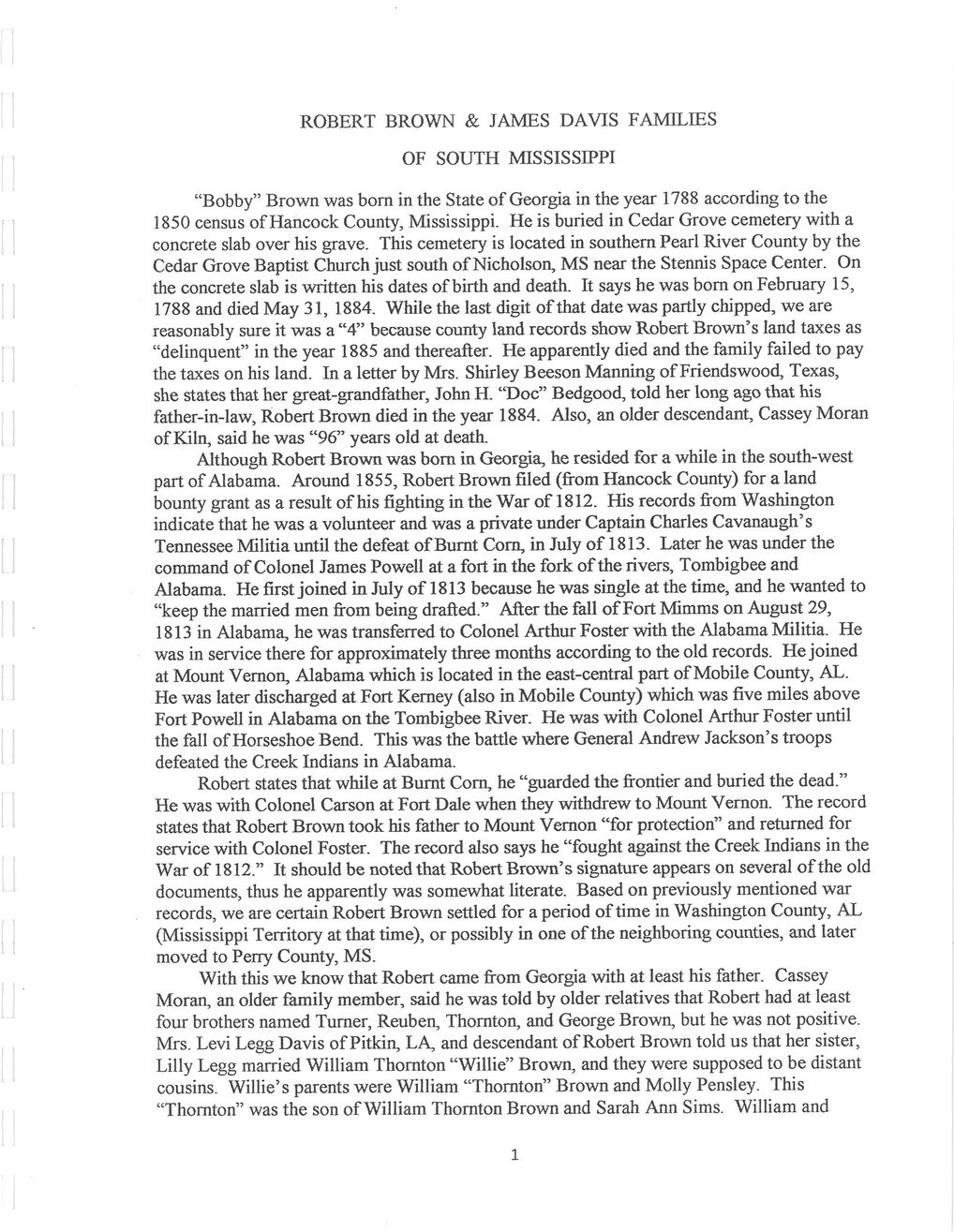This text was obtained via automated optical character recognition.
It has not been edited and may therefore contain several errors.
ROBERT BROWN & JAMES DAVIS FAMILIES OF SOUTH MISSISSIPPI “Bobby” Brown was bom in the State of Georgia in the year 1788 according to the 1850 census of Hancock County, Mississippi. He is buried in Cedar Grove cemetery with a concrete slab over his grave. This cemetery is located in southern Pearl River County by the Cedar Grove Baptist Church just south of Nicholson, MS near the Stennis Space Center. On the concrete slab is written his dates of birth and death. It says he was bom on February 15, 1788 and died May 31, 1884. While the last digit of that date was partly chipped, we are reasonably sure it was a “4” because county land records show Robert Brown’s land taxes as “delinquent” in the year 1885 and thereafter. He apparently died and the family failed to pay the taxes on his land. In a letter by Mrs. Shirley Beeson Manning of Friendswood, Texas, she states that her great-grandfather, John H. “Doc” Bedgood, told her long ago that his father-in-law, Robert Brown died in the year 1884. Also, an older descendant, Cassey Moran of Kiln, said he was “96” years old at death. Although Robert Brown was bom in Georgia, he resided for a while in the south-west part of Alabama. Around 1855, Robert Brown filed (from Hancock County) for a land bounty grant as a result of his fighting in the War of 1812. His records from Washington indicate that he was a volunteer and was a private under Captain Charles Cavanaugh’s Tennessee Militia until the defeat of Burnt Com, in July of 1813. Later he was under the command of Colonel James Powell at a fort in the fork of the rivers, Tombigbee and Alabama. He first joined in July of 1813 because he was single at the time, and he wanted to “keep the married men from being drafted.” After the fall of Fort Mimms on August 29, 1813 in Alabama, he was transferred to Colonel Arthur Foster with the Alabama Militia. He was in service there for approximately three months according to the old records. He joined at Mount Vernon, Alabama which is located in the east-central part of Mobile County, AL. He was later discharged at Fort Kemey (also in Mobile County) which was five miles above Fort Powell in Alabama on the Tombigbee River. He was with Colonel Arthur Foster until the fall of Horseshoe Bend. This was the battle where General Andrew Jackson’s troops defeated the Creek Indians in Alabama. Robert states that while at Burnt Com, he “guarded the frontier and buried the dead.” He was with Colonel Carson at Fort Dale when they withdrew to Mount Vemon. The record states that Robert Brown took his father to Mount Vemon “for protection” and returned for service with Colonel Foster. The record also says he “fought against the Creek Indians in the War of 1812.” It should be noted that Robert Brown’s signature appears on several of the old documents, thus he apparently was somewhat literate. Based on previously mentioned war records, we are certain Robert Brown settled for a period of time in Washington County, AL (Mississippi Territory at that time), or possibly in one of the neighboring counties, and later moved to Perry County, MS. With this we know that Robert came from Georgia with at least his father. Cassey Moran, an older family member, said he was told by older relatives that Robert had at least four brothers named Turner, Reuben, Thornton, and George Brown, but he was not positive. Mrs. Levi Legg Davis of Pitkin, LA, and descendant of Robert Brown told us that her sister, Lilly Legg married William Thomton “Willie” Brown, and they were supposed to be distant cousins. Willie’s parents were William “Thomton” Brown and Molly Pensley. This “Thomton” was the son of William Thomton Brown and Sarah Ann Sims. William and 1

Brown & Davis Families Robert-Brown-&-James-Davis-of-South-MS---Descendants-and-Related-Lines-002